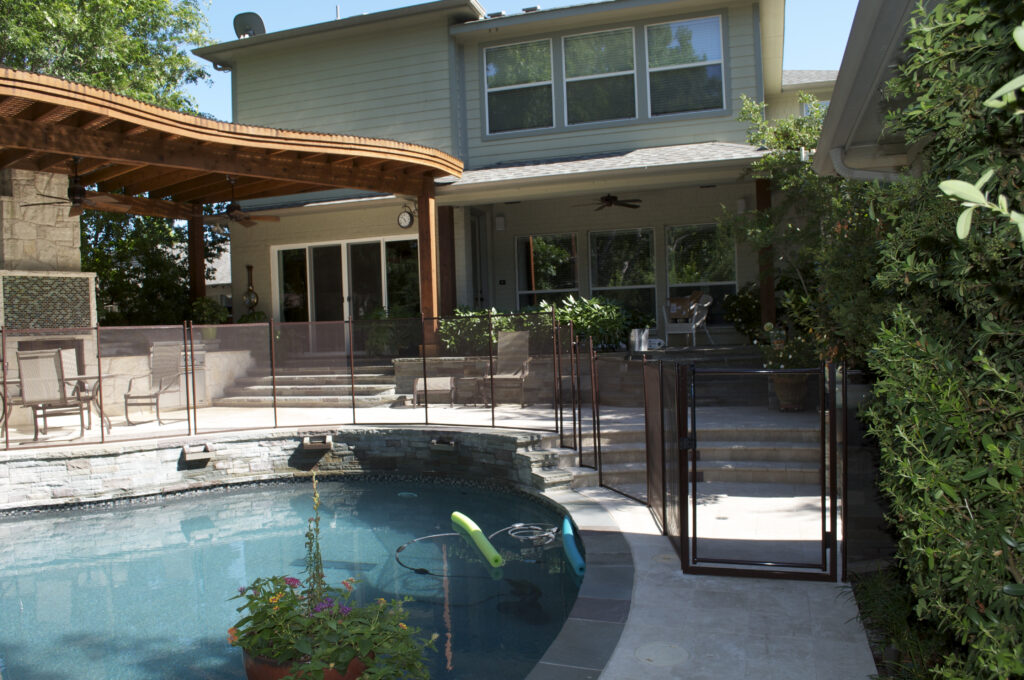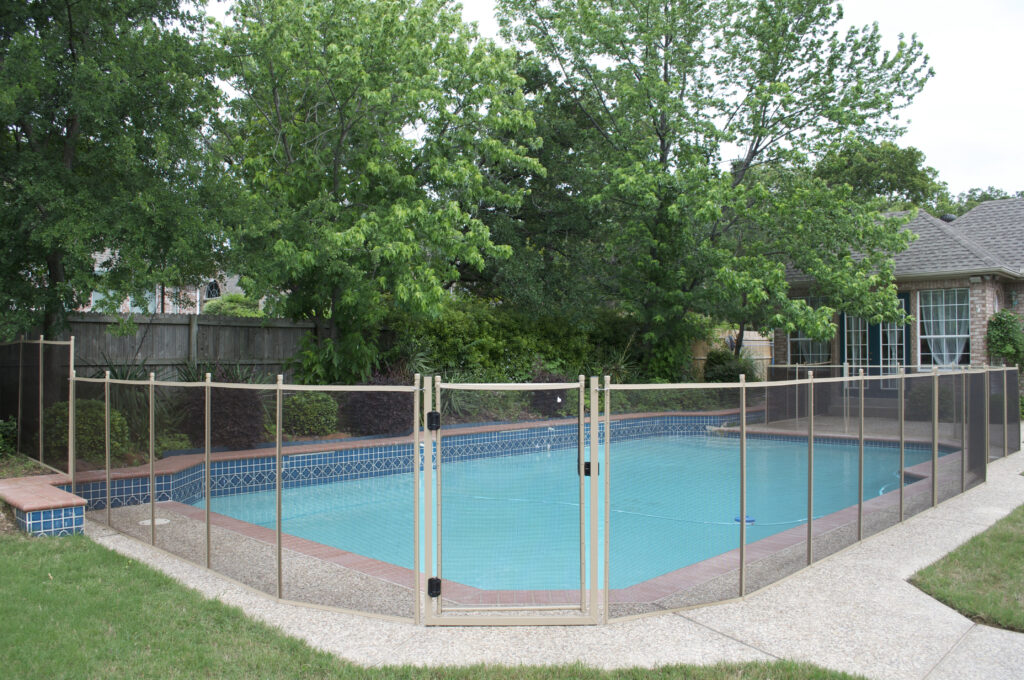When it comes to protecting your family and complying with local law, understanding pool fence requirements in Maryland is non-negotiable. Whether you own an in-ground pool, or plan to rebuild your already installed pool, Maryland’s pool barrier standards are designed to save lives and reduce accidents.
At Pool Guard, we take safety seriously. Our mesh pool fences are trusted by families across Maryland because they’re built to exceed legal standards and blend seamlessly into your outdoor space. Let’s dive into exactly what Maryland pool fencing laws require and how Pool Guard can help you meet the pool fence laws that Maryland homeowners adhere to.

If you’re a homeowner in Maryland with a residential pool, you’re likely required to have a compliant fence, especially if your property is a single-family or two-family dwelling.
According to the Consumer Product Safety Commission (CPSC), over 300 children under age 5 drown in residential pools every year. Inadequate fencing is one of the top contributing factors. Maryland’s pool fence laws aim to reduce that number, and so do we.
According to Maryland law, any structure used for swimming, recreational bathing, or similar purposes that holds water deeper than 24 inches is considered a swimming pool.
To ensure a safe environment around any backyard pool in Maryland, fences must meet the following minimum requirements, often based on the International Residential Code (IRC) Section 305 and CPSC recommendations:
To comply with pool fence requirements in Maryland, every residential pool barrier must be at least 48 inches (4 feet) tall. This height is mandated to prevent young children from simply stepping or climbing over the fence. Whether you choose mesh, wood, vinyl, or metal fencing, the vertical height must be measured from the finished grade level on the side of the fence that faces away from the pool.
Some counties may impose stricter height rules. Montgomery County requires a 5-foot fence, and Prince George’s County mandates 6 feet so always confirm with your local code enforcement office.
Maryland pool fence laws specify that the bottom of your pool fence cannot be more than 2 inches above the ground. This detail may seem small, but it’s critical. Gaps larger than 2 inches could allow small children or pets to squeeze underneath the barrier, bypassing the entire safety system.
This requirement is especially important for fences installed on uneven terrain, mulch, gravel, or other soft surfaces. During installation, make sure the ground is leveled or filled appropriately to maintain this 2-inch ground clearance standard along the entire perimeter.
In accordance with Maryland pool safety codes and CPSC recommendations, any gaps between vertical pickets or slats must not exceed 4 inches. This ensures a child cannot slip through the space between fence members.
This rule is particularly relevant for wrought iron, aluminum, and vinyl picket-style fences, where vertical spacing might seem decorative but must remain within code to be legally compliant. Even fences installed purely for aesthetics must meet this maximum gap requirement to prevent unintentional child access.
For homeowners considering chain link fencing, the rules are slightly different but equally strict. The mesh size of any chain link pool fence in Maryland must be no larger than 2.25 inches square. Openings larger than this could allow climbing or slipping through.
All gates that provide access to the pool area must be self-closing and self-latching. This means they must close on their own without human effort and automatically latch to secure the gate in place. Maryland mandates that the gate latch must be mounted at least 54 inches above ground level. If the latch is placed at less than 54 inches, the latches should be placed on the pool-facing side of the gate, at least 3 inches below the top of the gate to keep the latch out of reach for young children.
This regulation ensures that gates do not remain accidentally open due to wind, forgetfulness, or misuse. Self-closing mechanisms typically involve spring-loaded or hydraulic hardware, while self-latching systems include gravity latches, magnetic latches, or locking hardware that engages automatically.
A gate left open is a dangerous liability. That’s why self-operating pool gate systems are a mandatory part of Maryland pool barrier codes.
A compliant pool fence in Maryland must be designed to be non-climbable. If your fence includes horizontal rails or crossbars, they must either:
This prevents them from acting as “steps” that could assist children in climbing over. Decorative fence styles, particularly those made of wood or metal, should be reviewed for unintentional footholds or handholds that could be exploited. Mesh fences from Pool Guard are naturally non-climbable due to their flat, tensioned surface.
If your home forms one side of the pool enclosure, any door that leads directly from the house to the pool area must be equipped with an audible alarm. This alarm must:
These alarms are a critical backup in cases where a child might access the pool through the house rather than through the exterior gate. They’re legally required in most Maryland counties when the home forms any part of the pool enclosure.

Because Maryland does not have a universal statewide code for residential pools, enforcement is handled at the county level. Below is a detailed breakdown of how pool fence requirements in Maryland vary across key counties.
Montgomery County has adopted some of the strictest pool fence requirements in Maryland, prioritizing child safety with tighter definitions and higher barrier standards.
| Requirement | Standard |
| Minimum Fence Height | 5 feet |
| Applies To Pools With | Water depth ≥ 18 inches |
| Gate Requirements | Self-closing, self-latching at minimum 48 inches from the ground |
Prince George’s County enforces one of the highest pool fence standards in Maryland, with a 6-foot height requirement and mandatory inspection processes for both new and existing pools.
| Requirement | Standard |
| Minimum Fence Height | 6 feet |
| Applies To | All pools, including existing installations |
| Gate Requirements | Self-closing, self-latching, lockable, with a latch placement following the CPSC standards placed at least 54 inches above ground |
In Anne Arundel County, pool fence rules closely follow the International Residential Code and CPSC recommendations, offering homeowners a clear path to compliance.
| Requirement | Standard |
| Minimum Fence Height | 4 feet |
| Applies To | Pools with water depth > 24 inches |
| Gate System | Self-closing and self-latching with a latch placement at minimum 54 inches |
Yes. Removable mesh pool fences, like those offered by Pool Guard, are allowed as long as they meet the minimum requirements outlined by your local jurisdiction, including height, non-climbable surface, and self-latching gate mechanisms. Make sure the mesh fence is ASTM F2286-compliant and installed according to manufacturer and code specifications.
In most counties, yes. Installing or modifying a pool barrier typically requires a building permit, especially if the fence height exceeds 6 feet or if it’s part of a larger pool construction project. Always check with your county’s permitting department before starting installation to avoid penalties or rework.
No, not in most Maryland counties. Pool nets and covers may offer additional protection but cannot substitute a physical barrier unless specifically approved by local code. In almost all residential settings, a fence is legally required regardless of additional safety products used.
A county inspector will check your fence height, spacing, latch location, gate functionality, and any walls or doors included as part of the barrier. If any component fails to meet the requirements, you’ll be asked to correct it before receiving final approval.
Understanding and following pool fence requirements in Maryland isn’t just about passing inspections, it’s just as protecting the people you care about most. Every regulation, from fence height to latch placement, is there to prevent accidents before they happen.
At Pool Guard, we make compliance simple. Our fences are built to meet statewide and local Maryland codes, including Montgomery County’s strict standards and Prince George’s County’s inspection process. We provide free estimates, ASTM-compliant removable mesh fencing, professionally installed gates and alarms, and most importantly- the peace of mind you long crave for.
Ready to meet Maryland’s pool fence laws with confidence? Contact Pool Guard today to get your code-compliant fence installed in a matter of time.
Please fill out the form below with your information. Your local dealer will be notified about your inquiry.
Please fill out the form below with your information. Your local dealer will be notified about your inquiry.